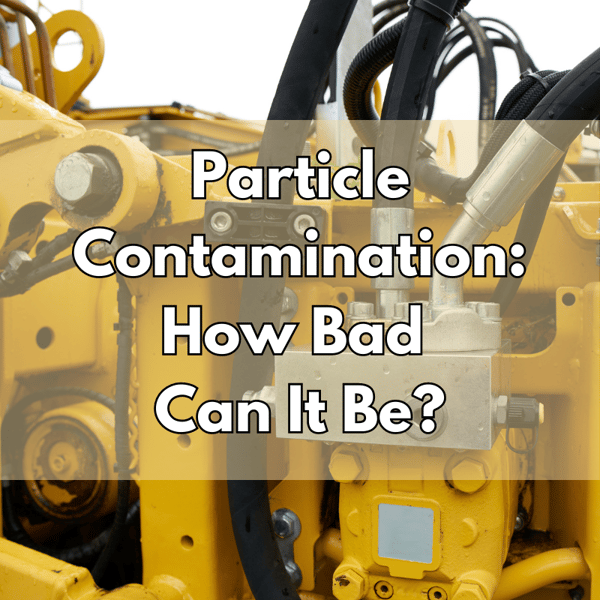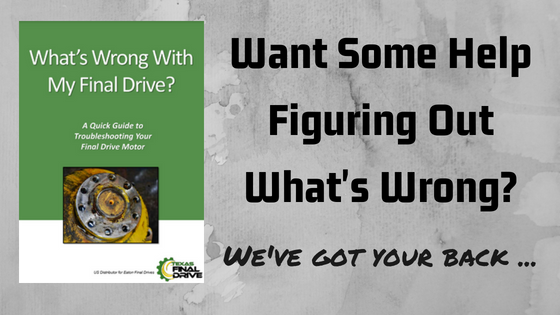Particles are tiny solids, and when they get into your hydraulic fluid, they will definitely cause problems! In this blog post, we’ll look at the types of particles that can contaminate hydraulic oil, their effect on your equipment, and the measures you can take to keep them out.

Here are some other blog posts you might find helpful:
Types of Particle Contamination
According to an article from Power & Motion, a well-filtered hydraulic system shouldn’t have particles larger than 10 microns in the fluid. Remember that human hair is 70 microns across; the smallest dirt particle the naked eye can see is only 40 microns. This means our ability to spot particle contamination in a hydraulic fluid sample is very unlikely.
Abrasive Particles
Abrasive particles are a serious issue when present in hydraulic fluid. Common types of abrasive particles include ….
- Shavings, chips, slivers, and tiny fragments of metal
- Sand, dirt, dust, silt, and similar environmental contaminants
- Fine granules from manufacturing operations
So what can these abrasive particles do to your hydraulic equipment? First, they will increase the wear rate of metal surfaces as they scratch, gouge, or polish critical surfaces. These wear mechanisms generate even more particle contamination as tiny pieces of metal are removed from the surface -- leading to even more wear. Critical components like the rotator group or bearings will experience surface damage that leads to inefficient internal leakage.
Non-Abrasive Particles
We usually focus on hard and abrasive particles, but there are also non-abrasive particles that can cause their own type of problem. Non-abrasive particles include things like
- Threads or fibers from cleaning rags
- Pieces from degraded seals,
The major problem with non-abrasive particles is their ability to clog, whether it's critical pilot valves or filters. The result is compromised performance and reduced efficiency. And this is especially true for newer machines built to tighter tolerances.
Effects of Particle Contamination on Hydraulic Equipment
Now that we’ve gone over the two categories of particle contamination, so let’s discuss the types of problems they cause in more detail.
Abrasive particles will damage surfaces, causing internal components to fail more quickly. They also increase friction, which means energy loss. In some cases, seals and soft components will be damaged, leading to both external and internal leakage. All of these -- friction, wear, soft component damage -- will eventually impair the performance of your equipment and reduce its useful lifespan.
And each of these effects impacts your final drive motor's efficiency and life span. No matter how high-quality your final drive motor is, particle damage will cause it to wear out more quickly.
Particles will accumulate in hydraulic filters, which cause pressure losses and restricted fluid flow when they become clogged. In addition, particles can accumulate in small orifices and valves that, when clogged, can cause hydraulic systems to malfunction and lead to eventual failure. Blockages and clogs can also be tricky to troubleshoot.
Over time, you can expect to see performance issues with specific components (such as final drives or pumps) or with the overall system as a whole. That can include inefficiency, which means your equipment is going to require more fuel to get the job done.
Preventive Measures and Maintenance
Let’s talk about four ways to minimize the impact of particle contamination on your hydraulic systems. First, regular fluid analysis and monitoring give you a snapshot of the condition of your fluid. Information about particle counts and contamination levels can help you determine where the contamination originated.
Next are filtration systems, starting with the hydraulic filters in your equipment. You shouldn’t skimp on the quality of the filters you install: these filters will prevent contamination from proceeding further into your system and help your equipment have a reasonable lifespan. To get the most out of your filters, they need a replacement schedule based either on experience with your equipment or manufacturer recommendations.
Another aspect of filtration systems that you should keep in mind is that hydraulic fluid, even direct from the manufacturer, will have some degree of contamination, which is simply unavoidable. Investing in a filtration cart would be useful, especially for equipment fleets. Filtration carts allow you to filter the hydraulic fluid right before it goes into your equipment and can significantly reduce the impact of the contaminants contained in brand new fluid.
Finally, the secret to consistent contamination mitigation lies in contamination control practices. This includes cleanliness standards for fluid handling and storage, as well as contamination prevention during maintenance and component replacement. For example, don’t leave hydraulic fluid containers out in the weather, where they can quickly acquire a coating of dust. Clean up your work area before you open up a pump or final drive motor. Use clean tools -- and use lint-free cleaning cloths (and avoid dirty rags) to avoid leaving any fibers or threads behind.
Conclusion
Whether you're dealing with abrasive or non-abrasive particle contamination, remember that it will eventually impact your final drive motor's performance and useful life. Here at Texas Final Drive, we always encourage our customers to take good care of their equipment, including the use of clean hydraulic fluid and the use of quality hydraulic filters.


